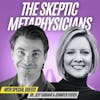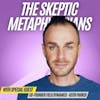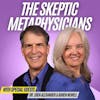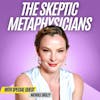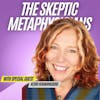We're All Doing Yoga Wrong - Stop Stretching! | Yogi Aaron

Ever thought you knew something inside out, only to realize you had it all wrong? This episode will leave you questioning everything you thought you knew about yoga. Prepare to be shocked as we uncover the hidden truth behind stretching and its impact on your body. In this eye-opening episode, successful yoga teacher, entrepreneur, and bestselling author Yogi Aaron presents a counterintuitive approach to yoga, advocating for muscle activation instead of stretching, and revealing the one meditation practice we all need to manifest our life's purpose. This empowering discussion not only challenges commonly held beliefs about yoga but also provides actionable insights for living a pain-free and purposeful life.
"When we stretch, we actually desensitize our nerve endings and compromise the communication system between our nerves and muscles. So, instead of stretching, focus on activating and strengthening the muscles that support your body." - Yogi Aaron
In this episode, you will be able to:
- Discover common misconceptions about yoga that may be holding you back from truly embracing its transformative power.
- Learn the importance of listening to your body and how to cultivate a practice that honors its unique needs and limitations.
- Explore the different approaches of Eastern and Western medicine in relation to yoga, and how they can complement each other for a holistic understanding of health and wellness.
- Understand the importance of creating a safe and supportive environment in your yoga practice, where you can explore and grow without judgment or pressure.
- Discover the root causes of physical ailments and how yoga can address them holistically, rather than just providing temporary relief.
- Gain insights into how yoga can deepen your connection with yourself and others, fostering a greater sense of well-being, balance, and harmony.
- Explore the essence and true purpose of yoga beyond the physical postures, and how it can positively impact all aspects of your life.
Take a deeper dive about this episode at the blog:
https://www.skepticmetaphysician.com/blog/stretching-bad
Get your copy of Yogi Aaron's book:
"Stop Stretching! A New Yogic Approach To Master Your Body and Live Pain-Free."
Available on Amazon.
Check out Yogi Aaron’s FREE 28 Day Affirmation series:
http://smpl.ro/manifest-life
Guest Info:
Website: https://YogiAaron.com
Podcast: http://smpl.ro/podcast-stop-stretching
Instagram: https://www.instagram.com/yogi_aaron
Facebook: https://www.facebook.com/groups/stopstretching
YouTube: https://youtube.com/c/YogiAaron
“Flexibility is not the goal of yoga. It's about finding stillness and joy within ourselves, which leads to mastering posture and overcoming the challenges of life.” - Yogi Aaron
Support the Show:
Rate/review Us Here: https://lovethepodcast.com/SkepticMetaphysicians
Purchase Merchandise: https://www.skepticmetaphysician.com/store
Buy Me A Coffee: https://www.buymeacoffee.com/SkepticMetaphys
Connect With Us:
Website: skepticmetaphysician.com
Facebook: @TheSkepticMetaphysician
IG: SkepticMetaphysician_Podcast
Tik Tok: @skepticmetaphysicians
Other episodes you'll enjoy:
The Life-Changing Benefits of Breathwork
https://www.skepticmetaphysician.com/spiritual-enlightenment-through-breathwork-mind-body-and-soul-healing
Shibari Healing and Sacred Sexuality
https://www.skepticmetaphysician.com/Shibari
Demystifying The Ancient Science of Ayurveda
https://www.skepticmetaphysician.com/demystifying-the-ancient-science-of-ayurveda
Yogi_Aaron
Karen: [00:00:00] Karen. Yes.
Will: There are so many types of meditation out there, right? There's loving kindness. There's sitting in stillness. There's heart centered. There are binaural beats and mindfulness meditations. There are even sound bath meditations. But what if I told you. That there is actually only one meditation that you need in order to manifest your life's
Karen: purpose.
Ooh. I
Will: want to know that one. Uh huh. And what if that one meditation was about to be revealed to us on this week's show? Well, that would make me very excited. I'd say let's get on with the show. So here we go. [00:01:00] So I see humanity as an analog to the eyes of a fly. Yeah, that's pretty weird just to throw that out there. I know, bear with me because the knowledge I have of a fly is minimal at best. Now, I only know what I know because of like fifth grade science stuff, right?
But what I do know is that. The eye of the fly is made up of hundreds or thousands of little ocular lenses that are only looking in one direction. They can't move to look in other directions. They just stay steady looking in one direction. That's all that they can do. so they can only see that one particular direction that they're facing in.
And it's only by the fly taking in All the information from the different lenses. Can the fly truly make a perfect picture of what's actually going on around them? So, you see, humans are like the [00:02:00] universe's eyes. See, we're all just facing one specific direction.
We're only seeing one thing, one perspective. And only by putting all of our perspectives together can we even come close to understanding what life is about or like. Now. Unlike the fly, who has no way of letting each lens communicate with each other, we, thankfully, have the ability to communicate with each other, to actually talk and learn from each other's perspectives, the other's view of the world.
And so we're able to put things together much more consciously than a fly can, or a fly's eye can. A fly needs the fly to put everything together, whereas we can actually put everything together. At least piecemeal, little by little, a little of the corner of the world, by a little corner of the world. By opening ourselves up to each other and learning from each other's perspectives, so that we can try to understand even a little bit more about what life is really about.
So, the next time you [00:03:00] see a fly, think of the fact that all these little eye lenses only have one perspective, And and learn from each other's perspectives, the other's view of the world. today we've got a special treat for you. He's an entrepreneur, a twice published and bestselling author, a podcast host.
A yoga teacher, co owner of Blue Osa Yoga Retreat and Spa in Costa Rica, and the creator of the revolutionary approach to yoga, Applied Yoga Anatomy Plus. Muscle activation, otherwise known as Ayama, it's easy for me to say, right?
Now he's journeyed from the wilds of Canada to New York City where he, started the global men's naked yoga movement to the sacred Himalayas where his leg was crushed by a boulder in a freak accident while trekking to the, uh, untamed jungles of Costa Rica, where he built a thriving yoga retreat center.
To today where he's on a [00:04:00] mission to help as many people as possible live a pain free life By teaching his revolutionary approach to yoga and he says he's accomplished all of this Not because he's fearless or extraordinary, although I'm sure he is, but because he had a powerful meditation practice alongside him throughout it all.
And he's about to reveal to us what that one meditation practice we all need to manifest our life's purpose today. Excited to talk to him and welcome to the show. Yogi Aaron, how are you?
Yogi Aaron: I am better now. Can you introduce me every day as I wake up out of bed? I love it.
Will: You know, I've always told Karen, I need to record someone saying something like that and just carry it around with me. So whenever I walk into a room, I've got this introduction, you know,
Yogi Aaron: Yes.
Will: it's always so much nicer when someone says, you know, stuff about you. So, um, well, as long as it's good stuff, well, that's
true.
Yogi Aaron: not just stuff. It's because I hear people read, you know, things about me all the time, but it's that you do it with such [00:05:00] enthusiasm and gusto. That's what,
Will: there you go.
Yogi Aaron: me going. It's just like, wow, I need that enthusiasm daily in my life.
Will: I have been accused of having lots of gusto, that's for sure. Among
Karen: other things, but we'll just stick with the gusto.
Will: Now we call it gusto here, okay? Alright, well I'm excited to talk to you because I, I mean, you're super intrigued to learn what that one meditation practice is.
But we're going to make everybody wait just a minute because... One of the things, as I was researching you, one thing I found about you that I was, I was astounded by, your type of yoga, like you have a very unorthodox approach, right? To the point of, Karen, get this, he believes, he feels, that stretching might actually do more harm than good.
Ooh. Ha, ha, what? We've been doing it wrong all along. How so?
Yogi Aaron: Well, I never like to say [00:06:00] anybody's been doing it wrong, but
Karen: We've been doing it wrong.
Yogi Aaron: Um, well, you know, we don't know what we don't know until we know that we didn't know. I mean, you know, we can go back in, in medical history and see so many examples of. The craziness that, um, you know, these people thought, but yeah, I, I started getting into yoga cause I was tight.
I was very athletic and I thought like most people I need to stretch. And it's, it's a natural progression. Cause if you look at people as they age, they tend to become more. Closed in, and I always observed people that looked youthful and were older, had more openness, more spring in their step, more mobility.
So I got into yoga. I started stretching and the very short story is it took me 25 years to realize it was. The stretching that was causing me more pain. As soon as they started stretching, I [00:07:00] developed back problems, knee problems, neck problems, lower back problems, all kinds of problems. And I never put two and two together until I ended up in a surgeon's office in an emergency room.
wanting to do a spinal fusion on my lower back. after doing this kind of stretching practice to be younger and be more youthful and virile at the age of 45, they're wanting to do a spinal fusion. And I actually know many people in their forties, early forties, even who have had a hip replacement surgeries and who are yoga teachers.
So. It's something isn't going right. And then that led me into studying the neuromuscular connection between what actually happens when we stretch. And I mean, nothing I'm saying is, is, you know, made up it's scientifically verified. These are, you know. People with PhDs will tell you, yeah, that's exactly what happens.
Um, and so the short, the short [00:08:00] answer is that when we stretch, we actually desensitize our nerve endings and those we desensitize our nerves so that. The communication system between the nerves or the central nervous system in the muscles becomes desensitized. So when you need those muscles to support your body, AKA like your bend over, you pick something up, you know, if your muscles aren't contracting properly, all of a sudden the body's not stable.
What does it do? It tightens up. And then that's when you hear people say, Oh my God, my back just went out, or I've got this huge kink in my neck. Those kinks in your back going out is a protective mechanism from your body to tighten up. So when your body, it feels like it, it's, it needs to, um, it's unstable.
It will just tighten up. And so stretching is the absolute wrong thing to do. I know many people like to go, well, that's your opinion. And this is my practice. Well, you can keep disabling your body. If you keep stretching, that's up to [00:09:00] you and end up, end up in a, in a emergency room.
Will: see Karen, I, and that, that is why I don't do yoga because I don't want to desensitize my nerves. I always knew it all. That's a lie.
Karen: Yes. ,
Will: Yogi, I, Aaron, I'm. I'm the worst. Like when you're talking about tight, like I can't, I can't don't even think about touching your toes. I can't touch my knees. I mean, I am so crazy.
It's ridiculous. Uh, and, and I've tried yoga before and inevitably I end up more in more pain than, than when I started. In fact, when we, when Karen and I first started dating, she took me to Bikram yoga and that was like, yeah, Hell, like, not only was I in pain, but I was in pain and sweating my ass off while I was in pain.
It was terrible, like, like awful. So then, if, if stretching is not what we're supposed to be doing when we're doing yoga, aren't you supposed to, when you're going into yoga poses, aren't you stretching?
Yogi Aaron: I, I'm, I don't teach stretching anymore. It's just the way that you [00:10:00] approach certain postures. You're also, I mean, one of the number one rules of what I teach is just go to 30 percent of what you think is your range of motion. Like if you're going to do a stretch, only go to 30%. Um, but the tightness that you're experiencing is just your, you know, it's just a symptom of that connection between your brain and your muscles not working properly.
That neuromuscular connection has become compromised. due to stress, due to trauma, due to overuse, you know, overuse, by the way, it could be as simple as you sitting for 8, 10, 12 hours a day. So that's like an overuse of your body in a stagnant posture. And that starts to compromise that neuromuscular connection.
So if we get that communication system working properly, you can have mobility back happening really quickly. But the tightness you're experiencing. Is your body protecting itself? It's like if you walked on ice, [00:11:00] you know, like you step out on ice. What do you do? You freeze up literally, so there's an autonomic nerve response to go into a protective state.
But I just wanted to say, Karen. Oh, my God. Throwing will into the fire like with Bikram literally 120 degrees.
Karen: mean,
Will: quite literally, it felt like my entire neurons were on fire. Well,
Karen: he didn't
Yogi Aaron: Yes.
Karen: to come. He was in that still trying to impress mode.
Will: Which, which translates to have to come, Karen, if you don't, you know, don't know the way that things go. Twice, right? Twice. And the second time I, you almost have to call the paramedics.
It was
that bad. It was bad.
Yogi Aaron: Sure.
Karen: I guess.
Will: Yeah, I got mad Bikram skill, baby,
Karen: like nobody's business. when you uncompromise the communication, can, how flexible can you be? Like I, in high [00:12:00] school and then I was on a dance team, I mean I could do like all the splits and kicks and everything. Can I get back to that?
Yogi Aaron: Well,
Karen: forget those days?
Yogi Aaron: I mean, I, no, I, yes and no. I mean, the first question I always ask people is why? Like, why do you want that? And then the second question, the follow up
Karen: had
Will: great hair back then, that's why. I did have
Karen: great hair.
Yogi Aaron: Well, then it's more about what we looked like, but no, but the, the, the bigger question is, you know, how much flexibility do you need to have to be happy?
Karen: we have a young daughter. she's 12 and she's starting to do sports and stuff and I want to be able to do a lot of that stuff with her and not cry. And not be paralyzed.
Yogi Aaron: yeah. So I would just say, you want to make sure that you are functioning optimally and that the communication system is working properly throughout your body. You know, how long will that take for you to get there? That just depends on history. It depends on what you're bringing to the [00:13:00] table. But the answer is I, I ended up in the surgeon's office.
It was six years ago and pretty quickly. Due to all of the work that I was doing on myself, I was able to actually get back into hiking and, doing all kinds of stuff that I thought I would never do again. And now I'm 51 and I feel stronger today than I have in a long time, long, long time. So, and, and I would also point out like one of the things that always fascinates me is, is sometimes I'll bend over and I'll pick something up and I'll be like.
There's no tightness in my body right now. My body is working well. Like I don't have my hamstrings pulling on me. I don't have my back like screaming at me. And that's a sign that I'm actually, my body is working really well. So how much, again, the question is always like why, and then how much flexibility do you really need?
I never really make that the goal. When my teacher Greg always says is when you have stability, you will have all the mobility in [00:14:00] the world that you could possibly want.
Will: So just to clarify for the slow person in the room. Um, when you, when you're talking about. getting to, I think you said 70%. So ideally what you're trying not to do is overstretch, right? You, you do need to stretch a little bit, or it's just like go beyond really, you know, non stretching at all.
Yogi Aaron: no, no, because what we've forgotten and it's like, you know, humans, as you know, have incredible amnesia, amnesia, amnesia. And so let me get, let me tell you, like, there's a pose, like I'll pull out a Bikram pose because I've done Bikram a lot. So one of the Bikram is you come over to the side, the side bending pose. And usually they'll cue it like, go, go, go, go. and try and feel the stretch on the side body. But in the way that I would set that up and I wouldn't, I would almost do it the same.
I would have actually people cross their arms and do it, but instead of [00:15:00] focusing on the stretch, what are actually the muscles that is moving? body in that post, the muscles that are moving the body is the lateral obliques and quadratus lumborum and a few of the other side bender muscles. So what you want to do is you want to activate those.
So when you're coming over, I would cue it more like squeeze the shoulder to the hip, and now you're engaging all of those muscles properly. It's not a focus on trying to stretch. And what we've forgotten again, the amnesia thing is. The, the role of muscles. So muscles always work in pairs. There's an, there's a muscle that's contracting, it's called the agonist, and there's the other muscle that's relaxing, that's the antagonist.
And so in yoga, where we've gone wrong in a lot of this kind of stretching ideas that we're focusing on getting the agonist to actually go longer. Then it should be instead of focusing on the muscle that should be contracting. If we focus on [00:16:00] that more than we increase our range of motion, and there's 100 percent accountability.
If I'm just focusing on stretching the whole nerve connection gets Discombobulated and is that a word? And,
Will: It is today.
Yogi Aaron: and, and then there's no accountability. And then we lose the muscle connection and you see that happen a lot. Like think about Bikram classes, people get up, they're not like bouncing up, they're like crawling up, pulling themselves
Will: they're in a puddle on the floor.
Yogi Aaron: of their muscles are working properly. They've all been like that whole neuromuscular connection is just gone.
And so people don't have that, like what some people call force output. There's no force output in the muscles. Muscles should always be able to contract and contract on demand. When they don't, there's a problem. And the result of that is stress in the joints. And the result of stress is pain. So that's why I'm on a mission to help people [00:17:00] become pain free.
Will: You
Karen: know, I love it. I want to sign up because
Yogi Aaron: Yeah.
Karen: mackerel, I've been in pain since, I blame COVID because I started working from home and Will was working from home and our daughter is homeschooling and so they got the good spots and I got the couch. So I sat on the couch with my laptop for a couple of years and now my back, it's terrible.
It's just terrible.
Will: It's terrible. Sure. Blame it on us. I
Karen: do. You got the office, Sienna got the dining room, I got the couch.
Will: Right. But now the office is sitting empty all day, every day. Now we're both sitting on the couch instead. Not
Karen: because I can't sit anywhere but the couch because I'm so messed up. You become
Will: one with the couch.
Karen: Hey. You fuse with the couch. No.
Will: All right. Well, this is fascinating because I've studied a little bit of Hinduism, right? And Hindu's all about yoga, but their yoga is, I mean, they really specifically talk about stretching in order to reach the, the, the mindfulness thing, right? So this is maybe not exactly, what the Hindus were, were thinking about when it comes to yoga.
We're, we're, you're talking more of a [00:18:00] Western physiology, let's keep ourselves healthy and young as much as possible, as long as possible.
Yogi Aaron: there's a lot to unpack and in that statement, um, but I'm gonna keep it I'll keep it really short and just leave it at this and if you want more you can ask me but in In the yoga scriptures, there's actually no reference to having to become flexible There's nothing and that's one of the that's a big misconception in in in the West like because we see these lanky sinewy You know, 18 year old men, uh, doing these incredible things.
But, as I would say to Karen, as she goes to a Bikram class wanting to look like them, you know, are you really an 18 year old, lanky, Cindy Huey, Indian boy?
Will: Not this time around.
Yogi Aaron: Ha ha ha ha ha ha ha ha ha ha ha ha ha ha ha ha ha ha ha ha ha ha ha ha ha ha ha ha ha You can
Karen: Bus meet Karen. Thank you. Will. All
Will: right. Um,
Yogi Aaron: that's all I have to say about that [00:19:00] for now.
Will: Okay. Well, I won't out then who it is, whose book I read. but it's an Indian who came over to the States, who, established an ashram who, that, that is pretty well known reading his book talks about. So a lot to unpack like you said.
Maybe it means
Karen: flexible of the mind. Maybe you misunderstood the whole book. Damn it.
Yogi Aaron: speak to that, but all I can tell you is that in scriptural reference, there is no reference to the importance of flexibility. Um, and what, what has happened is, and if you look at a lot of the teachers as they, As they age, they actually don't really do much asana. Asana is like something engineered for us to, I mean, I could go on and on and on about it, but it's really something for us to get a grip of our mind.
And so there's only two things that we have to master in order to master posture and that's stillness and then joy, [00:20:00] uh, or ease and effortless, which is the, you know, The result is joy. So if, if we can embody those two things, then we can master asana. And it's interesting because the whole idea of that teaching scripturally referenced in Sutra 246, 248, he says, if you can master those two qualities, you can overcome all the pairs of opposites of life, meaning that neither pain or pleasure will pull you in any direction that you just become this steadfast pillar of Steadiness, uh, in the world and for me, that's, that's a powerful teaching.
Will: No doubt about it. And I know now for sure that I'm doing it wrong because stillness and joy. When I do yoga, I do shakiness and pain. So it is not at all what I'm trying to do here. Uh
Yogi Aaron: Can I just tell you something? You're what I always refer to. I, I have two archetypes when I'm doing my teacher trainings and one of them [00:21:00] is called stiff Biff and you are just probably You probably would
Karen: so stiff biff
Yogi Aaron: in the class.
Karen: I'm going to get you a t shirt. Well, you know,
Will: you know, I, I might, I might actually wear it. I think it's, it fits really well.
Yogi Aaron: By the way, women can also be stiff biff. It's, it's gender neutral, so.
Will: Yeah. Pretty agnostic. Yeah, absolutely. All right. Well, this has been fascinating. We are speaking to Yogi Aaron, who is, enlightening us with the fact that we are doing it wrong. And I'm talking about yoga, of course. We talked about the fact that in scripture, there was nothing that said that you have to be flexible in, you're right.
Thinking back on, the Bhagavad Gita and the Upanishads, everything I've read. I don't recall ever hearing anything about being
Karen: stretchy. So,
Will: right. So, appreciate you, giving us a whole [00:22:00] new perspective on yoga because it is completely different than anything we've, I mean, it is completely anti intuitive, like it is completely opposite of everything we've ever heard about in yoga and Western world. It's incredible.
Yogi Aaron: Yeah.
Will: Now, before we left, and at the beginning of the show and in the middle of the show, and every other time, except for when we were, you know, we taught, we talked about this one meditation practice.
Now you've done a loss in your life and a lot of struggles that. Ultimately came out to be really good things, but you have to overcome
Yogi Aaron: Mm hmm.
Will: you mentioned meditation practice and everyone who listens to the show knows how important meditation is. I mean, it is a no brainer. Is it the first step?
It is a do not pass, go to not collect 200 bucks. This is, you've got to meditate. If you want to move down this path, whatever path you decide, meditation seems to be the gateway drug for all of it. But yet you say it is where you got my attention. You say that there is one practice. That you must do to manifest your life's purpose.[00:23:00]
Yogi Aaron, I must know what this practice is, cause I'm doing a thousand of them
Yogi Aaron: ha
Will: to know, cause I have not found it yet. And this is the ever elusive meditation practice, okay? Yogi Aaron, the floor is yours. The Skeptic MetaphysiciansThe Skeptic Metaphysicians
Yogi Aaron: Oh my god, I just felt the pressure go up like so many notches.
Will: Right.
Yogi Aaron: there's a couple of things that I kind of want to tee up first, but one of them is, so I was on the train, uh, coming from Vancouver to New York. And I, I decided for some crazy reason, which I never recommend to anybody else to take the train from, you know, West coast to East coast or vice versa.
It's one of the most horrible experiences you'll ever have on Amtrak. And
Will: well, yeah, I was gonna say if you have a sleeper car, it might not be so bad, but if you're just sitting there like in an airline seat next to the guy next to you sleeping on your shoulder, that's because I did that and that's not fun.
Yogi Aaron: It wasn't fun, but I was in my, you know, [00:24:00] late twenties and trying to save a buck. And I had my big bags and I was moving to New York and it was really moving there without any money in my pocket. And, but everything inside of me, you know, I'd been doing yoga for a little while and I felt like my Dharma, my purpose was pushing me to, uh, New York.
And I couldn't explain why just everything inside of me was just saying, go to New York. Study yoga, teach. I know it's a weird idea. Like, why would you go to New York to, uh, study yoga? But you know, there's so many great yoga teachers in New York and,
Will: Very
international city.
Yogi Aaron: kind of like intuitively just picked it out. And so anyways, I was on the train and I was just.
Feeling that kind of terror. Um, it was really the first time in my life at that point that I was kind of doing it on my own in many ways. I'd done stuff clearly on my own before, but just feeling that kind of terror, uh, bubbling up. And one of [00:25:00] the things that I really felt as that terror was bubbling up was how paralyzing fear is in terms of being, you know, of, of tapping into that inspirational source of that well of creative ideas like that.
that flow just stops like all of a sudden. And so I kind of closed my eyes and this meditation practice kind of dropped in. Now, before I tell you what it is,
Will: Oh my God. Yogi.
Yogi Aaron: Six. I'm learning something from watching you, so, so I have to jump ahead. And, um, so when I went to New York, part of my mission was to find a teacher.
Like I really wanted a teacher and Tantra started coming up for me, partly because of the work I was doing with the men. And then partly because. Of other things. And I was like, what is this Tantra business? And, uh, so I happened to pick up a magazine from [00:26:00] Kerpalo and there was right on, on one of the pages living Tantra and I had met my teacher, Rod.
And so one of the things that Rod, the veil back between the seen and the unseen for me. I was able to, Begin to get a glimpse of the sacred self and I'd never experienced that before, but one of the most interesting things was that my big takeaways was this idea of Tantra.
So a lot of people think of Tantra is like sex and, you know, uh, the yoga of sex. And usually if they go to a Tantra yoga workshop, they want to get rid of the yoga and get to the sex. So. Um,
Will: who doesn't? I mean, I thought was the whole point of me going to Bikram yoga.
Yogi Aaron: so,
Will: a loud. Sorry about that.
Yogi Aaron: so what, but the actual definition of Tantra means to [00:27:00] become limitless, to, to move beyond all limitations. That's the literal translation of Tantra. So, sitting on the train, I kind of started tapping into this, this meditation practice, this affirmation, this bhavana. In Sanskrit, the word we often use is bhavana, like something that you can really feel in your heart.
And the word Bob actually denotes like love. So to bring love into an idea and this affirmation just kind of dropped into my space. And it was, I'm opening myself up to the universe of limitless possibilities. And I just dropped into that practice, literally on the train on the way to New York, and the most amazing things started happening.
the fear immediately started to vanish. The, creative source of inspiration just started opening up to me. And that kind of. I would say like this sense of indomitable [00:28:00] willpower that each human being possesses became like a great force within me. Uh, and, you know, after moving to New York and, and of course when the train landed and, you know, and I got home and stuff like that, that fear obviously came back time and time and time again.
I had so many setbacks those first few months. And. But the saving thing, the thing that got me through, the thing that, that kept my focus, um, that kept me on my path of, of purpose and intention was that meditation practice. And anytime. I would just start to go into that fearful place. I was able to capture that Bhavana, that idea, that feeling, that affirmation, um, and remember who I was.
And that's the point of, I think, meditation. I mean, meditation has many different levels to it. At the source, a [00:29:00] meditation practice should bring us immediately, like in a split second, uh, back to who we are. And so that we can tap into that intuitive wisdom, that indomitable willpower, um, that creative source of inspiration.
And the funny, the reason why I told the story about my teacher is because that idea of Tantra is the embodiment of what just kind of dropped into me. You know, I, I call it sometimes spiritual downloads. You know, we get those spiritual downloads. And those, those spiritual downloads, you know, that, that one that I had on the train is the one that kind of propelled me to starting in New York with nothing, opening up a yoga studio, which went worldwide to opening up a yoga retreat center.
So, uh, be careful what you open yourself up to.
Karen: Oh, but it all sounds great. So I have a question about, [00:30:00] um, something that we'll mentioned in the introduction. You were hiking and you like your, your leg got crushed. That sounds horrible. Now my question is, was that before Hmm. Hmm. Or was it after? And did this help you heal? Tell me a little bit about that.
Yogi Aaron: Yeah, sure. no, I hadn't started the Ayama path yet. I was still a regular yoga teacher. Having said that, my, my spiritual practice of yoga and even somewhat the physical, um, and that's bigger discussion, but the, the spiritual practice prepared me for that, uh, event. Cause when it happened, I was in the middle of the Himalayas, I was 26 kilometers away from the vehicles and my femur literally broke in half.
Like you see, the x ray was like that. And so I get, I. I feel like everything in my life prepared me for that moment.
Karen: Yeah.
Yogi Aaron: [00:31:00] I'm opening myself up to the universe of limitless possibilities.
Karen: Right.
Yogi Aaron: Really? No, no joke. And so, but after that, on a physiological level, everything that was wrong with me before, physiologically speaking,
Karen: Hmm.
Yogi Aaron: just became exacerbated and, and worse. And so it, it didn't help things, but I had started glimpsing into the world of muscle activation and what was going on at that level.
but since then, I would say, like, I'm a lot stronger now than I ever was. So that feels really good.
Karen: I would think an injury like that would have like lasting pain and kind of repercussions, but it sounds like what you're doing maybe has been really helping it.
Yogi Aaron: Yeah, absolutely.
Karen: you just get over.
Yogi Aaron: No, I mean, I had to wear a knee brace for a long time. If I did any walking for an extended period of time now, I don't have to wear any braces or any supports or anything like that. Yeah,
Will: [00:32:00] So then let's get a little bit into the, what's, uh, Yama.
Yogi Aaron: a Yama. Yes.
Will: your technique, for lack of a better word, your approach, that's a better word. Your
approach is quite revolutionary, right? What makes a Yama different than most yoga practices out there?
Yogi Aaron: Well, the biggest one. So there's kind of a twofold question because I'm always using this coin like we're trying to flip the script in the yoga world and stop making it about stretching and flexibility. And so part of it, my focus is to bring yoga back to what it's supposed to be about. You know, how often do we ever go into a yoga class?
Mm hmm. And hear a teacher talking about how our practice can help us to manifest and live our life purpose. I never, um, you never hear a yoga teacher talking about that asana is, you know, the goal of asana is to help us become these steady forces in life where nothing pulls us [00:33:00] in either direction. That we have a Clear sense of purpose and who we are.
And I think that's one of the biggest shames of this biggest, you know, this marketing thing. So that's one part of a Yama and the other part that makes it very different is, well, number one, stop stretching
Will: right,
Yogi Aaron: and start activating. And so a lot of what I do is I, I kind of flip the script in terms of You know, what Karen was talking about before about wanting to put her foot up behind her head and, you know, and do all of those marvelous things, it's kind of asking, it's kind of getting people back into, let's use our yoga practice so we can become so that we can stand well in life and not have pain, um, and, and checking in with ourselves and using that as a tool to you.
You know, push us forward in life rather than, you know, the, the whole, um, idea of like putting your foot behind your head or learning to stand on your [00:34:00] hands or whatever it is, those are all kind of distractions at the end of the day, you know, and this is where the, the idea of posture can be the key to your liberation or the process.
Box of your own prison. There's so many people that are so focused on making something, make their body look a certain way that they've completely missed the mark and what the Asana, you know, the Asana is there to get you free, not to imprison you into a shape.
Will: So basically what I'm hearing here is that when you do yoga, it's not supposed to hurt.
Yogi Aaron: It should never hurt,
Will: It should never hurt, Karen C. It should never hurt. It never
Karen: hurts me, it hurts you.
Yogi Aaron: never ever.
Will: It is impossible. Now, did you not see me shaking and beating up and sweat and stuff? Because that's because I'm trying not to scream in pain.
I think I've blocked that out.
Karen: I was looking away. I wanted to be impressed.
Will: All right. Now, we've established the [00:35:00] fact that stretching is bad. We got it. Stretch, bad. Flex. I mean, flexibility is good, but not stretching. Stretching is bad. So is there, I mean, even You know, back in junior high when you're doing gym class and the first thing you do is put your right leg over your left leg and you bend down and you stretch.
Is there a safe way to stretch or should we just not stretch at all? Like maybe like get up in the morning and just keep ourselves like in a little bundle and walk to the shower and no stretching allowed or?
Yogi Aaron: Well, there's, there's nothing wrong with like, if you bring your, okay, bring your arms up to the sky. Now don't move your chest. Now, bring your biceps behind your ears a little bit more. Do you feel your back muscles working?
Karen: Yeah.
Yogi Aaron: Okay. So what are those back muscles doing? They're shortening. They're contracting.
And so that is a great movement. By the way, that's a fantastic way to start activating your trapezius muscles. If you bring your arms out [00:36:00] at 45 degrees. And just bring them back. You're going to feel your lower traps starting to engage, which is a great thing. Now, do you feel sort of a sense of opening in your chest?
Absolutely. When the, when the, when the trapezius muscle shortens, the result is the pecs start to relax. You're not trying to stretch the pecs. You're trying to engage the trapezius muscles. So when you engage, when you come at it from that perspective, if I'm, my focus now is engaging my traps. The pecs are going to start to naturally release now.
Some people might want to call that a stretch. I I don't Biomechanically, it's just they just relax. That's what's happening. They just they have to relax so that the Trapezius can contract now the tightness in the chest is not, is a symptom of the traps not being able to contract properly. And the result of them not contracting properly, guess what, is tight neck [00:37:00] all the way up into the top of your neck.
Yeah, the, the lower traps are, are actually the opposite of the upper traps. And so the upper traps tighten up because the lower traps are not doing their job properly. It's fascinating.
Will: dealing with a stiff neck.
Karen: Constantly. He gets migraines non stop.
Will: Mmm. Gosh. I got to ask though, because as we've already established, I am stiff biff and I can't get into the postures.
How could I possibly get into a posture if I don't stretch my way into it?
Yogi Aaron: Well. If you were folding forward and you said earlier that you couldn't touch your knees, the question is, okay, so what are the muscles that are contracting to bring you forward? Well, now we're looking at a lot of your, uh, let's call it the APAC, you know, your rectus abdominis. We're also looking at our oblique muscles.
Will: Well,
you, you,
Yogi Aaron: them. Ha, ha, ha, ha, ha, ha, ha, ha, ha. So what's [00:38:00] happening is those muscles are not shortening properly. And that's why you're feeling the tightness there. They're in a kind of static state. They're not working properly. So what we want to do is get those muscles working. And if I did, I could probably get you to increase your range of motion quite dramatically.
Will: Wow.
Karen: Wow,
Yogi Aaron: True story
Karen: so do you have videos that you, that people can, can get and watch how, how can
Will: she's, she's asking how can will Yes. Actually get much, get to where you're saying.
Yogi Aaron: So, yeah people can access all my content on yogiaran. com It's sort of the gateway into the Yogi Club Into my youtube channel into the book which is called stop stretching my podcast series called stop stretching I also if you fish around on my site and maybe I'll put it in the in the show notes Is the link to the affirmation series that we've, you know, because I created a 28 day affirmation [00:39:00] series that one that I shared with you is one of them and it's all about, you know, using these to manifest and live your life purpose.
But that's how people can access, uh, what I'm doing. I have a pain free series that's right on my site as
Karen: Ooh, I like that.
Yogi Aaron: So it takes people through kind of like trying to educate people a little bit on how they can live their best pain free life and why they're experiencing pain and what they can do about it.
Will: Hmm. Yeah. We're definitely going to add all those links to our show notes. Yogi Aaron, where have you been all
Karen: my life? I've been just the last 20 years.
Yogi Aaron: sure now.
Karen: Now I think we would be. Giving our listeners a disservice if I did not ask about something Will mentioned. Uh oh. You know, you mentioned it, I gotta ask.
Naked men yoga. What is that? I knew it. Why are they
naked? I
Will: knew it. I was waiting to see if we could get through the show without you bringing it up.
Karen: Well, you can't bring that up. And that's not something that you just mention and don't explain. [00:40:00] Yeah, you know, you know, people out there are going, come on, come on, get to the naked menu on the part.
Will: No, I think one particular person in the audience,
Yogi Aaron: just have to specify I was opening myself up to the universe of limitless possibilities. And,
Will: you were opening up in all kinds of ways.
Yogi Aaron: and, you know, what, when I was actually in New York, I remember the day really well, I was with a friend and I was walking in it. I happened to be walking across sixth Avenue which is the Avenue of Americas.
Will: I was just going to say that.
Yogi Aaron: And the top of my head opened up and this idea came into my head.
It was like, Oh my God, hot nude yoga. And, um, and you know, I, I did it, I started it for a few reasons, but one of them was, I just feel like men are sort of an underserved community in the world of yoga and I wanted to create a safe space and, and. [00:41:00] a fun space for men to come and just be men and, um, and what better way to do that?
And yeah, like, uh, uh, and, and, you know, when men get together, it's a powerful thing. Just like when women get together, it's a very powerful experience. And I just saw like, you know, my idea was to do it for six months and then call it a day and, you know, move on. It ended up becoming this like, you know, global phenomena, which is a whole other story, but it's just the community that came out of that was just incredible and one of the most enriching times of my life.
Karen: Well, I mean, I, I understand like, you know, going skinny dipping and stuff and just something about being out and naked. It's very freeing, but I don't think I'd want to be bending around a bunch of naked women.
Yogi Aaron: ha. Okay. Ha ha
Karen: be so self cautious.
Will: Have you never played naked twister, Karen?
Karen: [00:42:00] Actually, no. Oh, oh,
Yogi Aaron: ha
Will: me either.
Yogi Aaron: ha ha ha. That's, well, and that,
Karen: people to warm up, you know, like, to kind of, are they uncomfortable at first and then the group kind of starts to get more comfortable? Can you
Will: start with toga yoga and then work your way to...
Karen: Bong yoga?
Yogi Aaron: Now it was an all or nothin baby. Uh, no, there was no, and you know, you know how many times I got emails from people wanting just to come and watch the class? Oh my god, that
Karen: my gosh. Really?
Yogi Aaron: I mean, yeah, really, they had the nerve. Well, I'm
Will: think I saw that
on Cinemax.
Karen: My back's a little stiff. I don't think I can do it, but I want to know, you know.
Yogi Aaron: A big part of it was coming outside your comfort zone. And I can just say from my own younger, younger, younger years, nudity was always a big issue for me. I grew up in a very religious household, uh, in my younger years. And so the idea of getting naked and I remember when I started to, and [00:43:00] I, I just felt liberated, I felt free and I felt like there was like.
Something around me that had just come off and I was like, Hey, here I am. Um, and so that's also was a big part of it was just people taking a leap of faith and, and just getting outside of what, you know, becoming limitless. That's the definition of Tantra become limitless, go beyond your limitations.
Will: is it still going on now?
Yogi Aaron: It's become a worldwide, you know, phenomena.
There's been chapters of men's groups that have opened up all over the place. One of the things that I, Oh, I should not be saying this right now, but anyways, I actually created a ton of videos and, um, that are out there.
Karen: oh,
Yogi Aaron: of my intention was to put those videos out. And at the very least, like these different men's groups could put them on play and do them together or, you know, other people would become inspired by them and start teaching, you know, their own groups, [00:44:00] which is what exactly happened.
So again, opening up to the universe of limitless possibilities, very short, quick. Fun story. I was in Australia leading a retreat and we went to Alice Springs. Well, Alice Springs is homes to Ayers Rock. So I had all of these guys with me. We're going to Ayers Rock. We weren't going to do naked yoga there.
We're just going, you know, playing tourists. It was the tourist part of the Australian trip. We pull up to the gate four o'clock in the morning. Are you those naked guys?
Will: No, no, that's Thunder Down Under. That's
Yogi Aaron: we're in the middle of the outback in the middle of nowhere. Are you the nudies?
Karen: I'm sorry.
Yogi Aaron: my reputation preceded me.
Karen: Uh,
Will: I see that, uh, we're quickly running out of time, but I've got to ask because it's, it's the question that's been hanging out there for me for almost the entire interview. But going back to the stretching part of things, because obviously I am [00:45:00] focused as you can tell, because I'm blown away by all this, but this is such a different way of thinking of how to do yoga and things like that.
How, what's been the. The reception in the yoga community. Cause I can't imagine a lot of people being real happy with what you're trying to teach out there.
Yogi Aaron: Yeah. And I think that. Probably a good 30 to 50 percent, um, think I'm the devil incarnate or
Will: Right.
Yogi Aaron: Um, you know, it's threatening, it's threatening to them because the question, who am I if I'm not teaching, you know, how am I going to teach yoga if I'm not teaching stretching? Uh, and, and so that is a big problem.
For a lot of people to kind of like wrap their heads around. Also, like I met this one woman who works in the gym and part of her job is to stretch people. And here she is thinking she's doing a service and then she kind of finds out for me that she's not, um, actually. And I just want to kind of just say one thing really quick that [00:46:00] we can actually test muscle function.
So we can test you are strong. And then we do stretch and you're going to test wake and I've done I've done this countless times and it's and I've actually got a whole thing where I can get people to do it to themselves. You can test your own sort of force output and you feel the difference quite dramatically.
Actually, um, what happens before you stretch in after you stretch so that. But, but I would also say like 30 to 50 percent of people doing yoga recognize at some level or at a deep level that what they're doing is not supporting them. What they're doing is actually making them worse, but the yoga, the stretching part of it feels good.
You know, and and so this is like if you ask a lot of yoga teachers, why do we stretch? Well, because you feel good. Well, my response is doing a line of cocaine makes you feel good. You don't see us all running around doing cocaine [00:47:00] like like just because something makes you feel good. That should never be the answer about why we do something.
Um, so that's I would say it's like a 50 50 thing. A lot of people are very interested, but it is definitely making some waves. Ha ha ha ha ha
Will: only imagine yeah, but it kind of
Karen: makes sense because if you think like a rubber band, you know If you stretch it too much, then it it breaks or it doesn't work. It gets all you know, funky
Will: So was it was it what's term you used? discombobulated The
Yogi Aaron: discombobulated, yes! Ha
Karen: day Throw a juggernaut
Yogi Aaron: ha ha ha ha ha ha!
Karen: in there somewhere
Will: Now yogi Aaron do you still teach Yoga to people in person or online or anything other than I know you've got your content on your website But you still do teach that.
Yogi Aaron: Yeah, absolutely. And a lot of the content I actually film is when I'm with teaching students. Like I just finished doing a teacher training and I filmed a lot of content while I was doing the teacher [00:48:00] trainings. I do a lot of travel. I teach, you know, in different studios. I teach at yoga festivals. My main area of teaching is at Blue Osa, the yoga retreat I have in Costa Rica.
And we do teacher trainings there.
Will: Oh, I thought you I thought you invited us. I'm sorry
Yogi Aaron: Ha, ha,
Will: I'm hearing things. Sorry about that. No
Yogi Aaron: ha, ha. Come down and we'll film a radio episode.
Will: Let's do
Karen: it
Yogi Aaron: ha, ha, ha. Yeah, so I am teaching, yes.
Will: Okay. Well, awesome. Well, we're going to lay in all those links directly on show notes. All you need to do is go to skepticmanifestation. com, go to his episode page. You'll see all those links there. She can connect with Yogi Aaron directly. his stuff is mind blowing. It's been blowing my mind this entire interview.
So I'm thrilled that we got the chance to talk with you because, I never knew how badly I didn't know how to do yoga.
Yogi Aaron: Well, maybe you understand a little bit about why it was causing you so much pain to try and stretch, you know, [00:49:00] and I think this is one of the biggest things as well. Like in the yoga world, we talk about how yoga is about creating a safe space. It's about honoring our bodies. And yet when we're stretching, we're actually violating our body's own protective.
Self protective mechanisms. And what we should do instead is honor those protective mechanisms and address the cause of why it's tightening up. And that's where I come in.
Will: Right. It's a typical story of East versus West, Eastern medicine versus Western medicine. So, this has been fascinating, you and Erin, thank you so much for coming and sharing your wisdom with us. I am really looking forward to reintroducing myself to yoga because now that sounds like stuff that I might want to do, I might be able to do to start with.
So
Karen: thank you for that. So from Stiff Biff to Bendy Wendy.
Will: Karen
Yogi Aaron: I love it.
Will: no, no. Uh, I can't believe you just went there. I, I think we might have found our, uh, episode title[00:50:00]
Alright, well once again, Yogi Aaron, thank you so much for coming on.
Karen: It's been fun,
Yogi Aaron: Thanks guys.
And a huge thank you to you. We hope you've enjoyed this conversation as much as we have. If you did and you feel called to give back, we invite you to visit our website at SkepticMetaphysician.
com where you can donate to the show or subscribe as a member through our Buy Me a Coffee campaign. Your support will go a long way towards allowing Karen and I to bring you these wonderful conversations and teachings in more and more robust ways. Well, that's all for now, but we'll see you on the next episode of The Skeptic Metaphysician. Until then, take care.
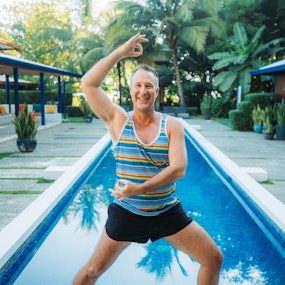
Yogi Aaron
Master Teacher, Muscle Specialist, Author
One of the most sought-after teachers today, Yogi Aaron is trailblazing a new path in the world of yoga. Known for his unorthodox perspectives on stretching and flexibility and how both cause more harm than good, his teachings aim to help as many people as possible live a pain-free life so they can realize yoga's true intentions.
He is the creator of the revolutionary approach to yoga — Applied Yoga Anatomy + Muscle Activation™ (AYAMA) and the online platform: The Yogi Club, host of the yoga podcast ‘Stop Stretching’, author of ‘Autobiography of a Naked Yogi’ and his new book ‘Stop Stretching! A New Yogic Approach To Master Your Body + Live Pain-Free', and is the Co-Owner of Blue Osa Yoga Retreat & Spa in Costa Rica where he leads Yoga Teacher Training Immersions year-round.
Yogi Aaron’s sense of humor, contagious laugh, and courageous adventurous spirit, makes him a stand-out and favored leading yoga teacher today.
















